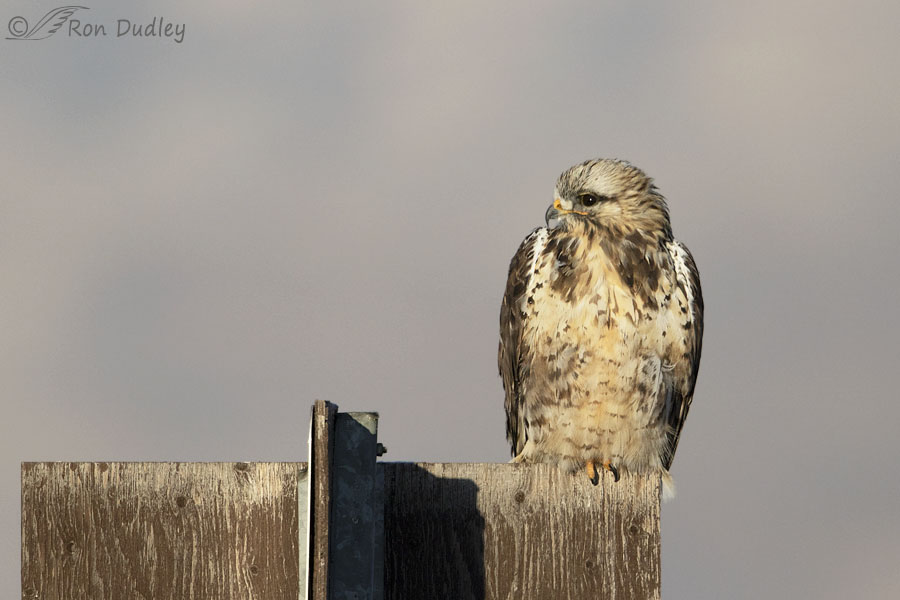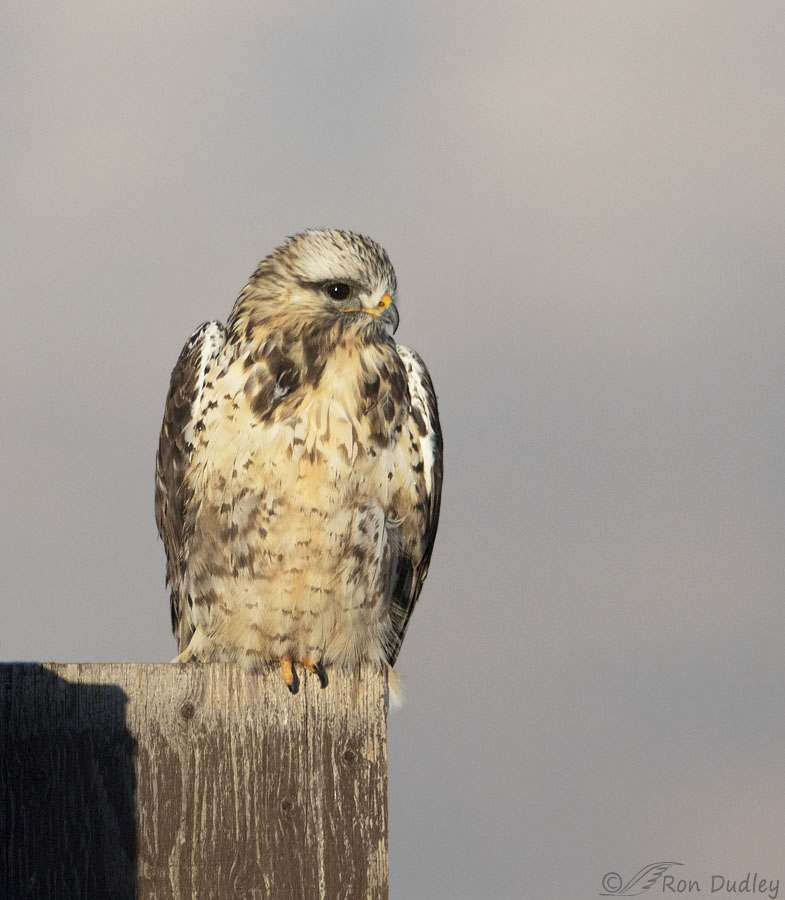Recently I’ve seen several “roughies” at a distance but they were only tiny specks in my viewfinder or flying away from me. Finally, yesterday morning this adult male took pity on me.

1/4000, 5/6.3, ISO 500, Canon 7D Mark II, Canon EF 500mm f/4L IS II USM + EF 1.4 III Extender, not baited, set up or called in
Usually when they first arrive from their arctic and subarctic breeding grounds they’re very difficult to approach. It typically takes them weeks to become acclimated to having vehicles and people nearby but this one surprised me. He was perched on an unattractive sign at Bear River MBR and wasn’t in the least bit nervous as I approached him along the auto tour route.
I seldom post photos of birds on signs or utility poles but my first decent shots of a Rough-legged Hawk each season are always a momentous occasion for me so I’m making an exception. I’ve deliberately cropped this photo to include the entire top part of the sign. With him looking to his right trying to minimize the sign is futile.
The background in these photos is the far away Promontory Mountains.

1/4000, 5/6.3, ISO 500, Canon 7D Mark II, Canon EF 500mm f/4L IS II USM + EF 1.4 III Extender, not baited, set up or called in
But with him looking to his left I could crop differently so the ugly sign isn’t quite so annoying, although that deep shadow at lower left certainly doesn’t help.
For the last four or five winters there’s been a single Rough-legged Hawk using this and another nearby sign at the refuge as habitual perches and I believe there’s a strong possibility it’s been the same bird each year. When these photos are compared to some taken last winter of a roughie on this same sign their markings appear very similar and both birds were adult males. The roughie in this area several years ago was a juvenile (if memory serves) but it still could have been the same individual.
A week or ten days ago one of my blog readers visiting the Yellowstone area told me in an email that Rough-legged Hawks were abundant up there and likely headed my way. I got fairly close to two of them yesterday morning so I’m thinking (hoping) he was right.
Ron
Note: As a bird photographer my definition of my “first bird of the season” is the first one I get decent photos of rather than the first one I see, no matter the species. Yet another reason I consider myself to be more of a bird photographer than a birder. There are other reasons too, for example I don’t keep lists.


Nice, I hope the first of many to come.
Ron, I like your photos. In the second photo this Rough-Legged Hawk looks very content to just be sitting there looking to the left and right. That beek could certainly tear apart a victim. Thank you
Thank you, Alice.
Could this be an early morning photo? Or could it be a regional color variation? The ones I’ve seen here in western Washington have a whitish front. Interesting head stripes on the left side but not on the right.
Yes, the photo was taken soon after dawn in warm light.
There’s also quite a bit of plumage variation in this species depending on sex and age. This from BNA Online about Rough-legged Hawks:
“Sexes dimorphic in adult plumage (a small percentage possess mixed plumage patterns of opposite sex, however), with tail and belly pattern most consistently different. This, combined with differences due to age and polymorphism, creates a wide array of plumage types. Most categorized as light morphs, but this highly variable and grading to extreme melanism in some individuals”
Are these a smaller bird? I guess I can look it up. Lol
Arwen, they’re just slightly smaller than Red-tailed Hawks, 2.2 lbs vs 2.4 lbs.
Thank you. I think it’s a perspective thing. This one appears small but maybe it’s just the body position.
I’ve not seen a Roughie yet this year myself. But, I haven’t been out in the right area very much. They are never common here in the winter but there are always a few around in open country if you look long enough. Maybe one for every 60-70 Red-tails. People consider me a birder but I think of myself much more as a bird biologist than a birder. I enjoy looking for birds when I am out, but I never chase rarities and I don’t keep lists. An unusual behavior in an American Robin is for more interesting than a rare bird, meaning a bird out of its normal range. I taught ornithology to seniors and grad students in Biology at the University of Oregon for 35 years and have led countless bird trips for different groups and I much prefer to lead trips or give talks to groups of beginning to intermediate “birders” than hard-core birders. My public presentations and my bird walks usually include much more natural history than just birds and many of the extreme birders don’t wish to stop to look at insects or flowers when there are more birds to see. But for me, it is much more interesting to look at a complete picture of a bird and where and how it lives instead of checking it off a list and moving on to the next one. I once saw a Red-breasted Nuthatch and a White-breasted Nuthatch fighting and falling out of a tree right in front of me where they continued rolling on the ground in a tight ball very aggressively fighting each other. I have never before or since seen any aggression or even much direct interaction between these two species. The intense birder in the group saw this but didn’t even stop walking. His focus was the Williamson’s Sapsucker he wanted to see that day. I preferred to watch the nuthatches.
Dan, it’s interesting how we see ourselves. I think of myself as a bird photographer who is intensely interested in behaviors. And the anatomy that allows those behaviors and the evolution that has produced them.
I’d have been focused on the nuthatches too, hopefully with my camera and lens. In that situation to hell with the sapsucker!
I don’t chase rarities either. In fact I’m even becoming hesitant to report them in some ways.
Ron, this message is actually directed to Dan Gleason considering he taught at Oregon State. Did he know Dr. Robert Storm, a legend at OSU, and did he know Don McKenzie and Tom Darrrow, also OSU grads who sought at Lewis and Clark College. In my younger years I knew these guys quite well and had lots of wonderful experiences in the field with them, mainly en eastern Oregon.
Wonderful photos, Ron. Personally, I love the hawk perched on the sign which looks weathered “shabby chic” with natural lighting and shadows. Signs don’t have branches that interfere with a hawk’s line of vision for hunting or clutter a talented photographer’s picture. Well-done, Ron. You captured the bird beautifully.
I’m glad you like both the bird and the perch. Thanks, Melanie.
When people ask me if I am a birder I answer “no, many times I don’t know what I’m looking at”. When they ask what I am looking for with my camera my typical response is “anything with wings”. Glad you found him (her). I don’t know whether they get down this far. Looking at their range map, here in S. Arizona we are at the absolute lowest part of their range but I’ll keep my eyes open. I did go to a talk this week about Rose-throated Becards. Apparently they are becoming a bit more common down here and someday I may get an opportunity with one.
Frank, My usual response to that question is “Anything with feathers”. And I have to answer the question often.
Nice! He’s a beauty. No accounting for their choice of perches….
He’s a beauty. No accounting for their choice of perches….  to echo others the sign appears to be well used for that purpose – different species, different seasons……… Glad he’s cooperative….
to echo others the sign appears to be well used for that purpose – different species, different seasons……… Glad he’s cooperative….
Thanks, Judy.
They have such sweet faces.
By the looks of the wear and scratch marks on the top inch or so of that sign it looks like a frequent perch for him and maybe others !!
Yes, other raptors use that perch too, Gary. And it’s an old sign so it’s had time to develop the wear and tear from birds.
Nice photos Ron. You envy me my Western Bluebirds, and I envy you your Roughies. I have never seen one here. Hopefully your Roughie will soon give you an opportunity for a natural setting photo.
“Hopefully your Roughie will soon give you an opportunity for a natural setting photo”
I’m afraid that’s not very likely, Everett. Elevated natural perches are almost nonexistent at Bear River so my only real chance with him is in flight.
Lucky you! No mistaking that head. I know what you mean about signs but sometimes you take what you get. I’m still waiting for these beauties to show up here. Hope springs eternal.
Kathy, as you know signs and utility poles are both a blessing and a curse for bird photographers. But since birds like them I won’t complain, too much…